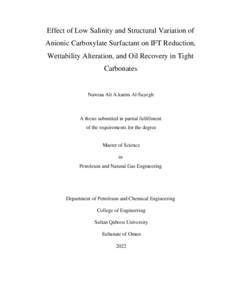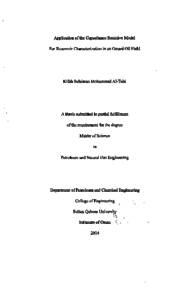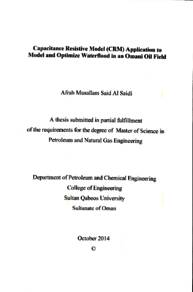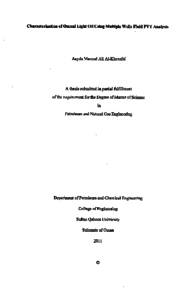Document
Diagenetic alterations and reservoir quality of al khlata formation : Wadi Dayqah, North Oman
Publisher
Sultan Qaboos University
Gregorian
2015
Language
English
Subject
English abstract
This study attempts to constrain the role and distribution of diagenetic alterations and their subsequent impact on reservoir quality evolution in relation to depositional environment (glacio-fluvial and glacio-lacustrine) of Carboniferous Permian Al Khlata Formation sandstones in Wadi Dayqah, North Oman. However, this study reveals that these sandstones have undergone various diagenetic alterations during eo- and mesogenesis. Eogenetic alterations include: (1) mechanical compaction of framework grains due to high rate of sedimentation (11) cementation by calcite and (iii) kaolinitization of mica, which are attributed to influx of meteoric water during the melting of glacier Mesogenetic alterations include: () illitization of mica (ii) chemical compaction and (iii) formation of quartz overgrowths. Chemical compaction is the most dominant and abundant found in both glacio-fluvial and glacio-lacustrine sandstones and affected mostly fine- to medium-grained sandstones. Compaction was more important than cementation in destruction of primary porosity enhanced by presence of mica along the grain contacts of detrital quartz, Quartz overgrowths found mainly in glacio-fluvial sandstones and are absent where illitized mica present around the detrital quartz grains. Microcrystalline quartz occurs in traces and precipitated as quartz cement at the grain contact of detrital quartz. Calcite cement is less common but observed in both glacio-fluvial and glacio-lacustrine sandstones. Illitized mica is found extensively whereas kaolinite found in traces in glacio-fluvial and glacio-lacustrine system. All these diagenetic alterations played a role in destroying the porosity of Al Khlata Formation sandstones. The findings of this work can help predicting the distribution of diagenetic alterations and their impact on reservoir properties of sandstones.
Description
Thesis
Member of
Resource URL
Arabic abstract
هذه الدراسة محاولة لفهم العوامل المتحكمة في توزيع التحورات اللاحقة وتاثيرها على تطوير جودة الخزانات النفطية و علاقتها بالبيئات الرسوبية (الجليدية النهرية والجليدية البحيرية) للعمر الكربوني البرمي لتكوين خلاطة الرملي بمنطقة وداي ضيقة شمال عمان. هذه الدراسة أظهرت أن هذه الأحجار الرملية تعرضت للعديد من التحورات اللاحقة المبكرة والمتأخرة. التحورات المبكرة تتضمن: (ا) التضاغط الميكانيكي المكونات الحبيبية الرئيسية بسبب معدل الترسيب العالي، (ب) المادة اللاحمة الكالسايتية و (ج) تكون الكاولينات من المايكا بسبب توفر المياه العذبة الناتجة من ذوبان الجليد. التحورات المتأخرة تتضمن (1) تكون الأيلات من المايكا، (ب) التظاغط الكيميائي و (ج) تكون المادة اللاحمة السيليكية. التضاغط الكيميائي هو السائد وموجود في كلا من الأحجار الرملية الناعمة والمتوسطة الحبيبات التابعة للبيئة الرسوبية الجليدية النهرية والبحيرية التضاغط أكثر أهمية من تكون المادة اللاحمة في التقليل من المسامية الأولية حيث أن التضاغط يزداد بين حبيبات الكوارتز المحاطة بالمايكا. المادة اللاحمة السيليكية تتواجد أساسا بالأحجار الرملية البيئات الرسوبية الجليدية النهرية وتختفي في الماكن التي ايلايت المايكا حول حبيبات الكوارتز. بلورات الكوارتز الناعمة تتواجد بكميات قليلة جدا على هيئة مادة الأحمة عند نقاط التقاء حبيبات الكوارتز المادة اللاحمة الكالسايتية في اقل شيوعا وتتواجد في الأحجار الرملية البيئات الرسوبية الجليدية النهرية والبحرية ايلايت المايكا يتواجد بكثافة بينما الكاولينأيت يتواجد بقلة في أنظمة البيئات الرسوبية الجليدية النهرية والبحيرية. جميع هذه التحورات اللاحقة تلعب دور أساسي في تخفيض المسامية لتكوين خلاطة الرملي. نتائج هذا العمل يمكن أن تساعد في التنبؤ بتوزيع التحورات الأحقة وتاثيرها على خصائص خزانات الأحجار الرملية
Category
Theses and Dissertations






